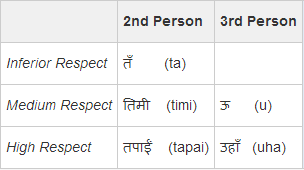What influences a language’s lexical and grammatical parts? The society that speaks it, of course. Culture defines what you will speak. Here, in Nepal, we have a system called ’Honorific Speech’ which differentiates speech between various levels of Respect. You don’t talk the same way (use the same wordings) to your seniors as you would to your friends. Honorific speech can also be called ’Respectful Speech’…it is a matter of personal choice.
So, what is it anyway?
Honorific Speech is differentiation in speech that encodes the relative social status of the participants of the conversation. In simple words, speech is differentiated among various people from various backgrounds. You use different wordings for your Seniors, different wordings for your Juniors, Friends etc. That means, different words are used for different individuals. It can denote or convey Politeness, Respect, Humility etc. In Nepali, Honorific Speech affects Verbs and Pronouns.
Honorific Speech is known as ‘आदर’ (aadar) in Nepali. The whole system of differentiation (like gender, plurality etc.) is called ‘पदसङ्गति’ (padsangati).
English doesn’t have this kind of system, though. In Nepali, it is obligatory to use Honour Speech all the time in certain situations, which will be revealed later. *drum rolls*
So, There are three levels of Respect (sometimes four depending on which dialect you are speaking).
Let’s just learn the three levels of Respect right now:
- निम्न आदर (nimna aadar) = Low Respect
- मध्यम आदर (madhyam aadar) = Medium Respect
- उच्च आदर (uchcha aadar) = High Respect
That wasn’t difficult, was it? Well, things are classified that way. Medium Respect (madhyam aadar) is also considered to be Neutral in some aspect. Low respect is sometimes offensive whereas High Respect is…high honours.
___
BRIEF DESCRIPTION
निम्न आदर (nimna aadar)
Literally means ‘Inferior Respect’. Use of words in this category is strictly limited to speaking with Juniors, Close Friends and Swearing. Its use outside of this sphere is considered highly offensive. Also considered informal in writing and appears in speech (mostly). However, use of this is considered by some people to bring friends ‘closer’. Maybe that’s why close friends use it?
मध्यम आदर (madhyam aadar)
Literally ’Medium Respect’, use of words in this category is extended to Acquaintances, Colleagues, Juniors, Friends etc. You use words inside of this sphere to talk with people who are familiar to you, like friends or colleagues. However, even this is considered to be improper if you use it to talk with your seniors. For them, there is a separate category given below.
उच्च आदर (uchcha aadar)
It literally means ’High Respect’, with words in this category considered formal and ‘non-attacking’. You use the words in this category to speak with Seniors, Teachers, Parents, Elder Siblings etc., places where Humility and Respect are expected. You do not use this to talk with Close friends and the use of this is typically seen in Books and writings. Words in this sphere is considered to be formal.
*bonus* अति उच्च आदर (ati uchcha aadar)
For the pompous people who claim to have *very* high knowledge of Nepali, there is yet another category whose name literally translates into ’Too high Respect’, because ‘High Respect’ was too informal and boring. Apparently, using words inside this ‘sphere’ will make you look like a humble person and honorifically literate.
_____
CLASSIFICATION OF PRONOUNS
So, pronominal system (system of pronouns) differentiates between respect too. However, this applies only on 2nd and 3rd Person Perspectives. There is no differentiation in 1st Person Pronouns (I, We)…well partly because you cannot talk using respect to yourself!

The above table (it is an image, actually) classifies Pronouns into their level of respect. As you can see, तँ (ta) is the least-respect denoting 2nd Person Pronoun, तिमी (timi) denotes Medium respect and तपाईं (tapai) denotes high respect. You might be wondering what ’X person pronoun’ means… 1st Person Pronouns are pronouns like I and We, 2nd Person Pronoun is ’You’ whereas 3rd Person Pronouns are He, She and It (in english, obviously). So that means, तँ (ta), तिमी (timi) and तपाईं (tapai) all translates into ’You’. So, there are three different ways to say ‘you’ in Nepali!
These are used in different contexts and interchange of them results in change of Respect denotation. For example, the sentence ‘You eat Rice’ can be translated according to the level of respect:
Low Respect: तँ भात खान्छस् (ta bhat khanchas)
Medium Respect: तिमी भात खान्छौ (timi bhat khanchau)
High Respect: तपाईं भात खानुहुन्छ (tapai bhat khanuhuncha)
More about this in upcoming Lessons.
________
CLASSIFICATION OF VERBS
You know that verbs are quite inflicted, so even when pronouns are not there to denote Respect, the verb can make a difference! Verb is the most important part in all languages (hopefully). The inflection in verb agrees with the subject and even when the subject is absent, one can get a notion of respect from the verb itself. As you can see in the above example (in the above section), different verb inflections are used even though the meaning remains the same: to eat. So why different forms? Because they denote different forms of respect.
More about this later!
__________
So that was the introduction to Honorific Speech. In order to sound formal, natural etc. this is a must. You cannot just use the same words for everyone! Finally, if you have any questions, do not hesitate to bother me. 🙂